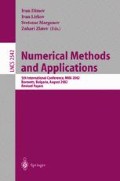Abstract
This paper presents the basic mathematical settings of a new theory of plausible and paradoxical reasoning and describes a rule of combination of sources of information in a very general framework where information can be both uncertain and paradoxical. Within this framework, the rule of combination which takes into account explicitly both conjunctions and disjunctions of assertions in the fusion process, appears to be more simple and general than the Dempster’s rule of combination. Through two simple examples, we show the strong ability of this new theory to solve practical but difficult problems where the Dempster-Shafer theory usually fails.
Access this chapter
Tax calculation will be finalised at checkout
Purchases are for personal use only
Preview
Unable to display preview. Download preview PDF.
References
Cheng Y., Kashyap R.L., “Study of the Different Methods for Combining Evidence”, Proceedings of SPIE on Applications of Artificial Intelligence, Vol. 635, pp. 384–393, 1986.
Dedekind R.,” Über Zerlegungen von Zhalen durch ihre grössten gemeinsammen Teiler”, In Gesammelte Werke, Bd. 1., pp. 103–148, 1897.
Dezert J., “Autonomous Navigation with Uncertain Reference Points using the PDAF”, Chapter 9 in Multitarget-Multisensor Tracking: Applications and Advances, Vol. 2, pp. 271–324, Y. Bar-Shalom Editor, Artech House, 1991.
Dezert J., “Optimal Bayesian Fusion of Multiple Unreliable Classifiers”, Proceedings of 4th Intern. Conf. on Information Fusion (Fusion 2001), Montréal, Aug. 7–10, 2001.
Dezert J., “Foundations for a new theory of plausible and paradoxical reasoning”, To appear in next issue of the International Journal of Information & Security, edited by Prof. Tzv. Semerdjiev, CLPP, Bulgarian Academy of Sciences, 40 pages, 2002.
Dubois D., Prade H.,“Théories des Possibilités. Application à la Représentation des Connaissances en Informatique”, Editions Masson, Paris, 1985.
Dubois D., Garbolino P., Kyburg H.E., Prade H., Smets, Ph., “Quantified Uncertainty”, J. Applied Non-Classical Logics, Vol.1, pp. 105–197, 1991.
Klawonn F., Smets Ph., “The dynamic of belief in the transferable belief model and specialization-generalization matrices”, in Uncertainty in Artificial Intelligence 92, pp 130–137, Dubois D. and Wellman M. P. and D'Ambrosio B. and Smet, Ph. Editors, Morgan Kaufman, San Mateo, Ca, 1992.
Mahler R., “Combining Ambiguous Evidence with Respect to Abiguous a priori Knowledge, I: Boolean Logic”, IEEE Trans. on SMC, Part 1: Systems and Humans, Vol. 26, No. 1, pp. 27–41, 1996.
Shafer G., “A Mathematical Theory of Evidence”, Princeton University Press, Princeton, New Jersey, 1976.
Shafer G., Tversky A., “Languages and designs for probability”, Cognitive Sc., Vol.9, pp. 309–339, 1985.
Smarandache F., “An Unifying Field in Logics: Neutrosophic Logic”, (Second Edition), American Research Press, Rehoboth, 2000 (ISBN 1-879585-76-6).
Smets Ph.,“The Combination of Evidence in the Transferable Belief Model”, IEEE Trans. on PAMI, Vol. 12, no. 5, 1990.
Smets Ph.,“The alpha-junctions: combination operators applicable to belief function”, Qualitative and quantitative practical reasoning, Springer, Gabbay D.M and Kruse R. and Nonnengart A. and Ohlbach H.J. Editors, pp. 131–153, 1997.
Smets Ph.,“The transferable belief model for quantified belief representation”, Handbook of Defeasible Reasoning and Uncertainty Management Systems, D. M. Gabbay and Ph. Smets (Editors), Vol. 1, Kluwer, Doordrecht, The Netherlands, 1998.
Smets Ph., “Data Fusion in the Transferable Belief Model”, Proceedings of 3rd Int. Conf. on Inf. Fusion (Fusion 2000), pp. PS–21–PS33, Paris, July 10–13, 2000 (http://www.onera.fr/fusion2000)
Sun H., he K., Zhang B.,“The Performance of Fusion Judgment on Dempster-Shafer Rule”, Chinese Journal of Electronics, Vol. 8, no. 1, Jan. 1999.
Zadeh L.A.,“A Theory of Approximate Reasoning” Machine Intelligence, J. Hayes, D. Michie and L. Mikulich Eds, Vol. 9, pp. 149–194, 1979.
Author information
Authors and Affiliations
Editor information
Editors and Affiliations
Rights and permissions
Copyright information
© 2003 Springer-Verlag Berlin Heidelberg
About this paper
Cite this paper
Dezert, J. (2003). An Introduction to the Theory of Plausible and Paradoxical Reasoning. In: Dimov, I., Lirkov, I., Margenov, S., Zlatev, Z. (eds) Numerical Methods and Applications. NMA 2002. Lecture Notes in Computer Science, vol 2542. Springer, Berlin, Heidelberg. https://doi.org/10.1007/3-540-36487-0_2
Download citation
DOI: https://doi.org/10.1007/3-540-36487-0_2
Published:
Publisher Name: Springer, Berlin, Heidelberg
Print ISBN: 978-3-540-00608-4
Online ISBN: 978-3-540-36487-0
eBook Packages: Springer Book Archive

